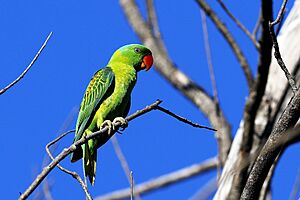Blue-naped parrot facts for kids
Quick facts for kids Blue-naped parrot |
|
|---|---|
 |
|
| Conservation status | |
| Scientific classification | |
| Genus: |
Tanygnathus
|
| Species: |
lucionensis
|
| Synonyms | |
|
Psittacus lucionensis Linnaeus, 1766 |
|
The blue-naped parrot (scientific name: Tanygnathus lucionensis) is a beautiful bird found all over the Philippines. People also call it the blue-crowned green parrot or the Luzon parrot. In some places, it's known as the Philippine green parrot or simply pikoy.
Contents
About the Blue-Naped Parrot
Have you ever wondered how scientists give names to animals? This is called taxonomy. The blue-naped parrot got its scientific name, Psittacus lucionensis, from a famous Swedish scientist named Carl Linnaeus in 1766. The word lucionensis comes from Luzon, an island in the Philippines where this parrot was first found. Today, scientists place this parrot in a group of birds called Tanygnathus.
There are four main types, or subspecies, of the blue-naped parrot:
- T. l. lucionensis: Found on the islands of Luzon and Mindoro.
- T. l. hybridus: Lives on the Polillo Islands. This type has less blue on its head.
- T. l. salvadorii: Found in most other parts of the Philippines.
- T. l. talautensis: Lives on the Talaud Islands.
What Does It Look Like?
The blue-naped parrot is a medium-sized bird, about 31 centimeters (12 inches) long. It is mostly green, which helps it blend in with the trees.
It has some cool blue markings:
- A light blue patch on the back of its head and neck.
- A pale blue color on its lower back.
Its shoulders have a cool pattern, looking like orange-brown scales on black feathers. The feathers under its wings are dark, but the ones closer to its body are green.
Where It Lives and What It Eats
You can find the blue-naped parrot all over the Philippines. It also lives on the Talaud Islands and some islands near Borneo. There are even some groups of these parrots that were brought to Borneo by people, for example, in Kota Kinabalu.
These parrots like to live in forests that are growing back, at the edges of forests, and even in farms where fruit trees are grown. They can be found in places up to 1,000 meters (about 3,300 feet) high.
Blue-naped parrots usually fly in small groups, often less than twelve birds. They love to eat different kinds of food, like:
- Mangoes
- Berries
- Seeds
- Nuts
- Grains
When it's time to have babies, they make their nests inside holes in trees.
Protecting the Blue-Naped Parrot
Sadly, the blue-naped parrot is facing some challenges. Because people are cutting down forests, these birds are losing their homes. Also, some people catch these parrots illegally to sell them as pets.
Because of these problems, the blue-naped parrot has become rare on most islands. However, you can still find more of them on Mindoro and Palawan islands. Organizations like the Katala Foundation are working hard to protect these amazing birds. They are worried about the increasing illegal trade of these parrots, especially on Palawan. It's important to protect these beautiful birds so they can continue to fly freely in the Philippines!
Gallery
-
A blue-naped parrot in Luzon, Philippines







